|
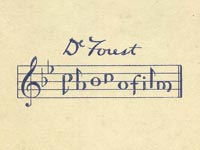
Lee de Forest.
De Forest Phonofilm, ca. 1924.
Motion Picture, Broadcasting
and Recorded Sound Division (54)
|
De Forest Phonofilm
Lee de Forest was already well known as the inventor of the
Audion tube-a device which amplified weak radio signals-when
he turned his attention to talking pictures. Building on the
work of German inventors, in 1922 he developed the Phonofilm,
a system for recording synchronized sound directly onto film
stock. The Phonofilm was used almost exclusively to record
stage performances such as vaudeville numbers, speeches, and
musical acts rather than to compete with silent film features.
|
Phonofilm Film Strip
An enlarged series of de Forest Phonofilm frames shows the
sound imprinted directly onto the film stock as parallel lines.
These lines photographically represent electrical impulses
from the microphone and are translated back into sound waves
when projected using specialized equipment. However, because
the majority of movie theaters in the U.S. were affiliated
with the major Hollywood studios, Lee de Forest experienced
great difficulty in finding venues for his system and the
company declared bankruptcy in 1926.
|
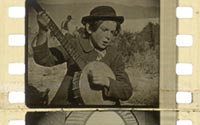
De Forest Phonofilm frames,
ca. 1925.
Reproduction.
Motion Picture, Broadcasting
and Recorded Sound Division (55)
|
|
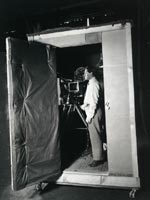
Cameraman inside soundproof
camera booth,
ca. 1926.
Copyprint.
Prints and Photographs
Division (56)
|
Vitaphone Camera Booth
The Vitaphone camera was linked directly to a turntable that
recorded sound onto a blank phonograph disc. This system generated
a great deal of noise while in operation, so the entire apparatus
was housed in a soundproof booth. Working with University
of California at Los Angeles and other archives, the Library
has preserved many of the early Vitaphone productions in modern
sound-on-film formats.
|
Vitaphone Projection Booth
The projection of a Vitaphone film required very precise
synchronization of disc and film. Each reel of film has a
"start" frame, and the projectionist would line up that frame
in the projector's gate. The disc would be cued on the attached
turntable by placing the stylus at the first groove, marked
with an arrow etched into the record. At the flip of a switch,
the film and disc would accelerate to their appropriate playing
speed.
|
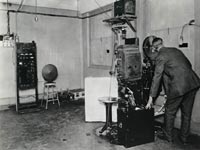
Vitaphone projection booth,
ca. 1926.
Copyprint.
Prints and Photographs
Division (58)
|
|
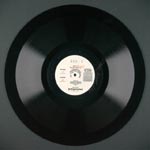
Roy Smeck.
Pastimes,
Camden, New Jersey: Victor Talking
Machine Company, July 14, 1926.
Vitaphone disc.
Motion Picture, Broadcasting
and Recorded Sound Division (59)
|
Vitaphone Disc
Western Electric's sound film system was called Vitaphone,
and, unlike the Phonofilm, it recorded sound onto sixteen-inch
discs. Each disc corresponded to one reel of film, or about
ten minutes. In contrast to conventional records, the grooves
in a Vitaphone disc were less rigid in order to enhance sonic
quality. However, each disc could be used only for twenty
plays before replacement, thus the check boxes on the label.
This recording is of Roy Smeck, "The Wizard of the String,"
in a short film, Pastimes, presented at the Vitaphone's
world premiere at the Warner Theatre in New York, August 6,
1926.
|
DeForest Phonofilm Advertisement
Stars of the variety stage were the featured attractions
in many of the sound films of producer Lee DeForest.
|
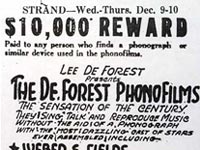
Phonofilm advertisement.
The Daily Herald (Biloxi), 1925.
Reproduction.
Courtesy of Joe Showler (59a)
|
|
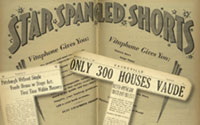
Composite of assorted
news
clippings from Variety, 1929.
Reproduction.
Courtesy of Variety.
General Collection
(60)
|
Variety Headlines
Trade newspapers such as Variety and Billboard
chronicled vaudeville in great detail and provide researchers
with unique and invaluable information about the rise and
fall of variety stage entertainment.
|
Film Derived from Popular Radio Show
In this 1933 motion picture, vaudevillian Ed Wynn brought
his "Perfect Fool" stage character to the screen. The title
of the film is derived from Wynn's Texaco Oil radio program
of the time, The Fire Chief.
|
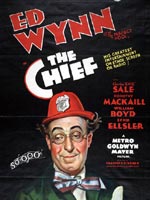
The Fire Chief,
1933.
Movie Poster.
Prints and Photographs
Division (63a)
|
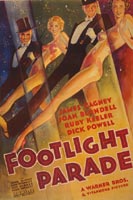
Footlight Parade.
Movie poster, 1933.
Prints and Photographs Division (63A.2)
[digital ID# cph 3g07412]
|
Footlight Parade
Several Warner Brothers musicals of the early 1930s are
remembered for lavish numbers choreographed by Busby Berkeley.
The negligible plots of these films were based upon the backstage
intrigues of stage revues. In Footlight Parade,
James Cagney portrays a producer of stage musicals who discovers
that talking motion pictures have nearly eliminated the demand
for live revues. He applies his skills to create musical
numbers that are performed live between movie showings. The
extravagance of the productions belie their supposed theater
setting. |
Film Set in Radio Station
Dick Powell starred in this 1934 musical motion picture
set in a radio station. The broadcasting setting provided
a means of justifying performances from Ted Fio Rita and
the Four Mills Brothers. |
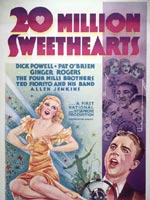
Twenty Million Sweethearts,
1935.
Movie Poster.
Prints and Photographs Division (63b)
|
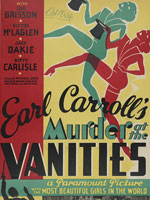
Murder
at the Vanities.
Movie poster, 1934.
Prints and Photographs Division (63A.3)
[digital ID# ppmsc-04763]
|
Murder at the Vanities
Earl Carrol’s stage revues of the 1920s and early
1930s, called Vanities, were among several rivals to Ziegfeld’s
Follies. The beautiful women featured in the annual Vanities were renowned as the most scantily clad of the genre. One
historian has described the Vanities as “a blend of
tastelessness, nudity, and overpowering spectacle.” This
filmed backstage murder mystery continued the Vanities tradition
with musical numbers which barely skirted the guidelines
of Hollywood’s censors.
|
“It’s better to be looked over than overlooked.”
In Belle of the Nineties, Mae West, who wrote the script
for this film and a handful of other films during the 1930s,
stars as an 1890s cabaret entertainer. Singing such sultry
songs as “My Old Flame” and “Memphis Blues” with
Duke Ellington’s orchestra behind her, West simultaneously
projects sexiness and sincerity. Even though the script was
ruthlessly edited by the censorship board, West managed to
maintain her signature innuendo.
|
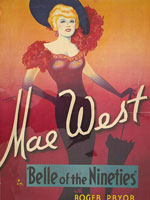
Belle of the
Nineties.
Movie poster, 1934.
Prints and Photographs Division (63A.4)
[digital ID# ppmsc-04385]
|
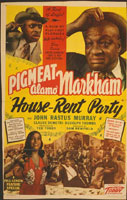
House-Rent Party.
1946,
Movie Poster.
Prints and Photographs Division (63B.2)
|
House-Rent Party
The musical comedy formula that evolved from vaudeville
consisted of variety acts embedded within a very slight plot.
It remained popular in the 1940s and extended into motion
pictures that were geared toward African American audiences.
This 1946 Dewey "Pigmeat" Markham film is one such
vehicle. |
Vaudeville Stars on the Screen
Vaudevillian Jack Pearl's "Baron von Munchhausen" character
became widely popular on the radio series The Ziegfeld Follies
of the Air in 1932. The Baron was best known for his retort
to those who doubted his wild exaggerations: "Vas you
dere, Sharlie?" He was joined in the motion picture
Meet the Baron by several other veterans of the stage. |
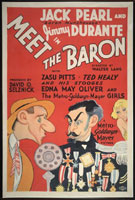
Meet the Baron.
1933,
Poster.
Prints and Photographs Division (63B.1)
|
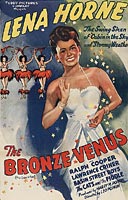
The Bronze Venus.
Movie poster, 1944.
Prints and Photographs Division (63B.4)
Digital ID: LC-DIG-ppmsca-05525
|
The Bronze Venus
In 1938, Lena Horne made her motion picture debut in a small
film, The Duke is Tops. A melodrama set in a show
business milieu, the film was directed toward African American
audiences and featured many musical performers and variety "specialty" acts.
In 1944, after Lena Horne had become an internationally-renowned
motion picture and recording star, the film was reissued
as The Bronze Venus. |
Sheet Music for "I'd Rather Be Blue Over You."
Assuming that vaudevillian Fanny Brice would be as popular
a film star as Al Jolson had become, Warner Bros. cast her
in the 1928 talking picture, My Man, where she
sang "I'd Rather Be Blue Over You." However, the film was
not a commercial success and Brice did not develop a truly
national audience until her "Baby Snooks" character became
popular. No print or negative is known to exist of the film, My
Man. |
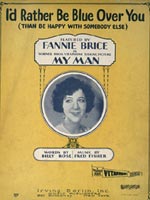
Billy Rose and Fred Fischer.
"I'd Rather Be Blue Over You."
My Man.
New York: Irving Berlin, Inc., 1928.
Sheet music.
George Moss Collection,
Music Division (65)
|
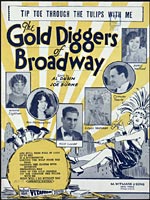
Al Dubin and Joe Burke.
"Tip Toe Through the Tulips With Me,"
from Gold Diggers of Broadway.
New York: M. Witmark and Sons, 1929.
Sheet music.
Music Division (65.2)
|
"Tip Toe Through the Tulips With Me"
Motion picture historians have established that the 1929 musical, Gold
Diggers of Broadway, was a critically-acclaimed and commercially
successful musical film. It featured a number of popular variety stage
stars, including talented dancers, singers, and wisecracking comics.
Sadly, no print or negative is known to exist of this excellent film.
Thus, it is remembered now only for the song, "Tip Toe Through the
Tulips With Me," revived notoriously in the late 1960s by novelty performer
Tiny Tim. |
|
Telegrams about The Big Broadcast of 1938
|
|
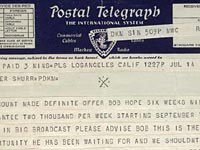
Telegram from Louis Shurr to
Lester Shurr, July 14, 1937.
Postal telegraph.
Bob Hope Collection,
Motion Picture, Broadcasting
and Recorded Sound Division (66-s1)
|
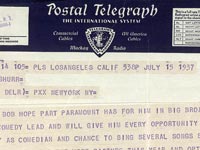
Telegram from Louis Shurr to
Bob Hope,
July 15, 1937.
Bob Hope Collection,
Motion Picture, Broadcasting
and Recorded Sound Division (66)
|
|
By 1937 Bob Hope had starred in several Broadway musicals
and appeared in short films, yet it was not a given that he
would become a motion picture star. Telegrams in the Hope
Collection such as these show how close Hope came to turning
down his role in the film The Big Broadcast of 1938.
His success in that film made Bob Hope a motion picture star.
|
|
Sheet Music for "He's a Good Man to Have Around"
Lusty song-belter Sophie Tucker was another
in the parade of vaudeville stars who passed in front of sound
movie cameras in the beginning of the talkie era. Her 1929
film debut Honky Tonk, however, was not a success.
It was a story of a misunderstood performer, one of too many
which followed the success of Al Jolson's The Jazz Singer.
No print or negative is known to exist of the film Honky
Tonk.
|
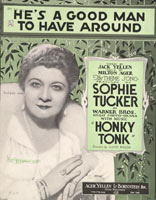
Jack Yellen and Milton Ager.
"He's a Good Man to Have Around."
Ager, Yellen & Bornstein, Inc.: New York, 1929.
Sheet Music.
Music Division
(65.1)
|
|

Telegram from Louis Shurr to
Bob Hope,
July 15, 1937.
Bob Hope Collection,
Motion Picture, Broadcasting
and Recorded Sound Division (66)
|
Telegram about The Big Broadcast of 1938
In 1937 Bob Hope was being considered for roles in major
motion pictures. Although he had already starred in several
Broadway musicals and appeared in short films, it was not
obvious that he would become a motion picture star. Telegrams
in the Hope Collection such as this one show Hope's ambivalence
about appearing in The Big Broadcast of 1938
and how close he came to turning down the role in the film.
|
The Big Broadcast of 1938 Publicity Book
In The Big Broadcast of 1938 Bob Hope played
the master of ceremonies on an ocean liner, introducing a
variety of entertainers, such as Shep Fields and His Rippling
Rhythm and Wagnerian soprano Kirsten Flagstad. In the film,
three ex-wives of the character Hope played are on board the
ship as he prepares to be married for the fourth time, to
a character played by Dorothy Lamour.
|
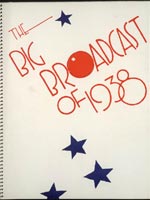
The Big Broadcast of 1938
Publicity Book,
1938.
Bob Hope Collection,
Motion Picture, Broadcasting
and Recorded Sound Division (67)
|
|
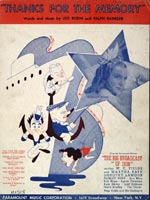
Leo Robin and Ralph Rainger.
"Thanks for the Memory."
New York: Paramount Music
Corporation, 1937.
Music Division
(68)
|
"Thanks for the Memory"
In The Big Broadcast of 1938 Bob Hope's character
sings "Thanks for the Memory" to his ex-wife, played by Shirley
Ross. In this bittersweet song the couple nostalgically recounts
the bad times in their relationship, as well as the good.
The wistful song immediately became a hit and has been associated
with Bob Hope as his theme song ever since.
|
Damon Runyon Newspaper Column
The Big Broadcast of 1938 was not well received
by critics. The New York Times called it "a hodge-podge
revue." However, the song "Thanks for the Memory," sung by
Bob Hope and Shirley Ross, made a favorable impression on
critics as well as viewers. Damon Runyon's column about the
song is credited with giving a significant boost to Bob Hope's
film career.
|
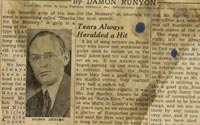
Damon Runyon.
"The Brighter Side."
Los Angeles Examiner,
March 13, 1938.
Reproduction.
Bob Hope Collection,
Motion Picture, Broadcasting
and Recorded Sound Division (69)
|
|
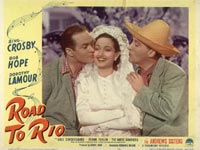
Road to Rio lobby
card.
National Screen Service Corporation, 1948.
Bob Hope Collection,
Motion Picture, Broadcasting
and Recorded Sound Division (70)
|
Road to Rio Lobby Card
The Road to Rio was the fifth of the Road
series of comic adventure films. It was the highest-grossing
motion picture of 1948.
|
Life Magazine Cover, February 4, 1946
Critic Brooks Atkinson wrote that the first job of a vaudevillian
is to "break down the resistance of the house by direct force
of personality." Life Magazine's cover tribute
to The Road to Utopia features Bob Hope and Bing
Crosby as vaudevillian go-getters.
|
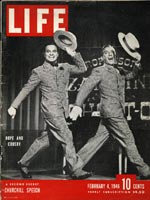
Life Magazine,
February 4, 1946, cover.
Bob Hope Collection,
Motion Picture, Broadcasting
and Recorded Sound Division (71)
|
|
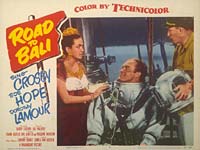
Road to Bali.
Lobby card, 1953.
Card 2
Bob Hope Collection,
Motion Picture, Broadcasting
and
Recorded Sound Division (70.1)
|
Road to Bali Lobby Card
The Road to Bali was the sixth
of the seven Road series of comic adventure films.
It was the only Road picture shot in color.
|
|
Hope, Crosby, and Lamour in The Road to Morocco
|
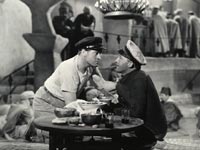
|
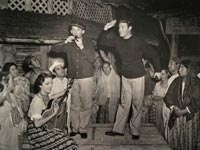 |
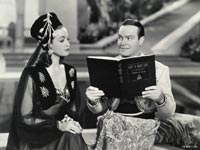 |
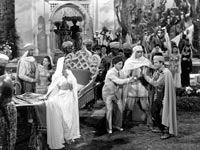 |
|
Photographs from
The Road to Morocco in 1940.
Copy Prints.
Bob Hope Collection,
Motion Picture, Broadcasting
and Recorded Sound Division
(73a, 73b, 73c, 73d)
|
|
The Road film series began as a script intended
for Jack Oakie and Fred MacMurray, who turned down the roles,
as did George Burns and Gracie Allen. Bob Hope and Bing Crosby
were paired for the motion picture, made as The Road
to Singapore in 1940. The Hollywood Reporter
said of Hope and Crosby in Singapore, "Paramount
has created one the greatest comedy teams in film history
. . . these two complement each other . . . perfectly. ."
Another reviewer later called the series, "a national institution,
a periodical gathering up of contemporary gags and attitudes
that could only be American."
|
|
| 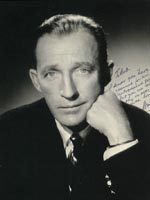
Autographed photograph
of Bing Crosby, 1945.
Courtesy of Bob Hope Archives (74)
|
Autographed Photo of Bing Crosby
Bob Hope and Bing Crosby shared a friendship and mock rivalry
which predated the first Road film in 1940. Years
before they began performing in films together, they joked
about their mutual passion for golf, needling each other at
personal appearances and on radio shows. The two first appeared
together at the Capitol Theater in New York in 1932.
|
The Road to Utopia script page Annotated by
Bob Hope
The great popularity of the "Road" series of
films was due primarily to the chummy yet competitive, rapport
between Bob Hope and Bing Crosby. The compatibility of their
partnership includes a rhythmic ease to their dialogue, especially
when they are exchanging insults.
|
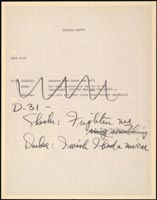
The Road to Utopia script
page.
Typewritten manuscript with
holographic emendations, 1946.
Bob Hope Collection,
Motion Picture, Broadcasting
and
Recorded Sound Division (75.1)
|
|
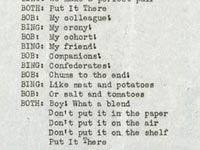
"Put it There Pal" lyrics
with handwriten emendations, 1946.
Bob Hope Collection,
Motion Picture, Broadcasting
and Recorded Sound Division (75)
|
"Put it There Pal" Lyrics, with Hope and Crosby's Contributions
Reputedly, Bob Hope and Bing Crosby improvised so much in
filming their Road pictures, that Hope once called
out to a writer on the set, "If you recognize any of [your
lines], yell 'Bingo'!" No doubt, this is an exaggeration,
but the handwritten corrections to the typed lyrics to "Put
It There, Pal" give evidence of the team's embellishment of
their scripts.
|
The Seven Little Foys Lobby Card
As one of the most popular motion picture stars of the 1940s
and 1950s, Bob Hope could chose the films in which he would
appear and could participate in the profits of those films.
Hope was one of the producers of the 1955 screen biography
of vaudevillian Eddie Foy, The Seven Little Foys.
|
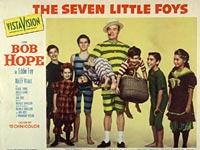
Lobby card for The Seven
Little Foys.
National Screen Service
Coporation, 1955.
Bob Hope Collection,
Motion Picture, Broadcasting
and Recorded Sound Division (77)
|
|
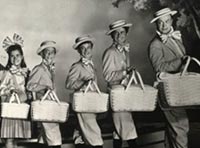
Composite photograph for
The Seven Little Foys, 1955.
Copyprint.
Bob Hope Collection,
Motion Picture, Broadcasting
and Recorded Sound Division (78)
|
Hope and Foys Photograph
Depicting turn-of-the-century vaudevillian Eddie Foy was
a natural choice for veteran variety entertainer Bob Hope.
But the film was a departure for Hope because he played Eddie
Foy as only a partially sympathetic character. The film centers
on Foy's life after the early death of his wife, and depicts
many serious as well as comical incidents. This role shows
off Hope's broad range of acting abilities.
|
The Seven Little Foys Musical Score
In The Seven Little Foys Bob Hope, as Eddie
Foy, courts his wife-to-be singing Bert Williams's classic
song, "Nobody." The musical score to The Seven Little
Foys was composed by Joseph J. Lilley, who also scored
many of Elvis Presley's motion pictures.
|
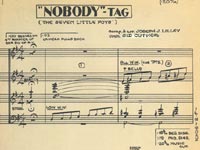
Joseph J. Lilley.
Musical score for
The Seven Little Foys,1954.
Bob Hope Collection,
Motion Picture, Broadcasting
and Recorded Sound Division (79)
|
|
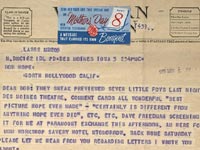
Report from preview screening
for
The Seven Little Foys,1955.
Bob Hope Collection,
Motion Picture, Broadcasting
and Recorded Sound Division (80a)
|
Acclaim for The Seven Little Foys
The Seven Little Foys was a success with critics
and audiences. Even those who did not praise the film admired
Bob Hope's portrayal of Eddie Foy.
|
Bob Hope schedule for promotion of The Seven Little
Foys
Throughout his career Bob Hope worked tirelessly to assure
the success of his projects. On the Sunday of Bob Hope's appearance
on the Ed Sullivan Show to promote The Seven
Little Foys, he rehearsed his two segments for the television
program, gave two radio interviews, and capped the day with
a cocktail party to promote the motion picture.
|
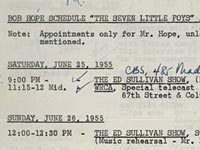
Promotion schedule for
The Seven Little Foys,
June 25-28, 1955.
Bob Hope Collection,
Motion Picture, Broadcasting
and
Recorded Sound Division (80a-s1)
|
|
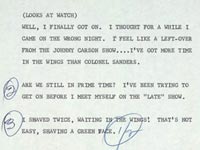
Jokes from the Academy Award
Ceremony, 1969.
Typewritten manuscript
with emendations.
Page 2
Bob Hope Collection,
Motion Picture, Broadcasting
and Recorded Sound Division (83)
|
Academy Award Ceremonies Jokes
Self-deprecation is a major ingredient of Bob Hope's humor,
as is obvious in his frequent jokes about never receiving
an Academy Award for a film. No Bob Hope Oscar night was complete
unless Hope made a few jokes denigrating his own acting abilities.
Hope first hosted the Academy Award ceremonies in 1940 and
served as its masters of ceremonies more often than any other
performer.
|
Hope's Honorary Oscar from 1953
Bob Hope was one of the most popular movie stars throughout
the 1940s and early 1950s, appearing in more than seventy
feature films. He received three honorary Academy Awards for
his humanitarian services and contributions to the motion
picture industry, including this one in 1953.
|
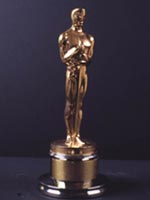
Honorary Academy Award statuette,
1953.
Courtesy of Bob Hope Archives (82)
|


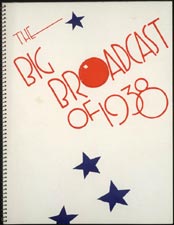
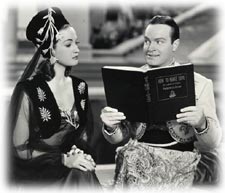 Bob
Hope's success in The Big Broadcast of 1938 and resultant
starring film roles brought him the opportunity to team with Bing
Crosby and Dorothy Lamour in The Road to Singapore
(1940). It is for this film and the subsequent series of Road
pictures with Crosby and Lamour that Bob Hope is best known
and still appreciated as a movie star. In each of the seven Road
pictures made between 1940 and 1962, Hope and Crosby portrayed
second-rate show business troupers who were also third-rate con
men. The settings were always exotic locales, and the plots were
burlesques of stock adventure melodramas. Much of the films' immediate
and enduring popularity results from the chemistry between Hope
and Crosby: their relaxed comfort with one another; their playful
competitiveness; and the natural, improvisational feel to their
repartee.
Bob
Hope's success in The Big Broadcast of 1938 and resultant
starring film roles brought him the opportunity to team with Bing
Crosby and Dorothy Lamour in The Road to Singapore
(1940). It is for this film and the subsequent series of Road
pictures with Crosby and Lamour that Bob Hope is best known
and still appreciated as a movie star. In each of the seven Road
pictures made between 1940 and 1962, Hope and Crosby portrayed
second-rate show business troupers who were also third-rate con
men. The settings were always exotic locales, and the plots were
burlesques of stock adventure melodramas. Much of the films' immediate
and enduring popularity results from the chemistry between Hope
and Crosby: their relaxed comfort with one another; their playful
competitiveness; and the natural, improvisational feel to their
repartee. 






































